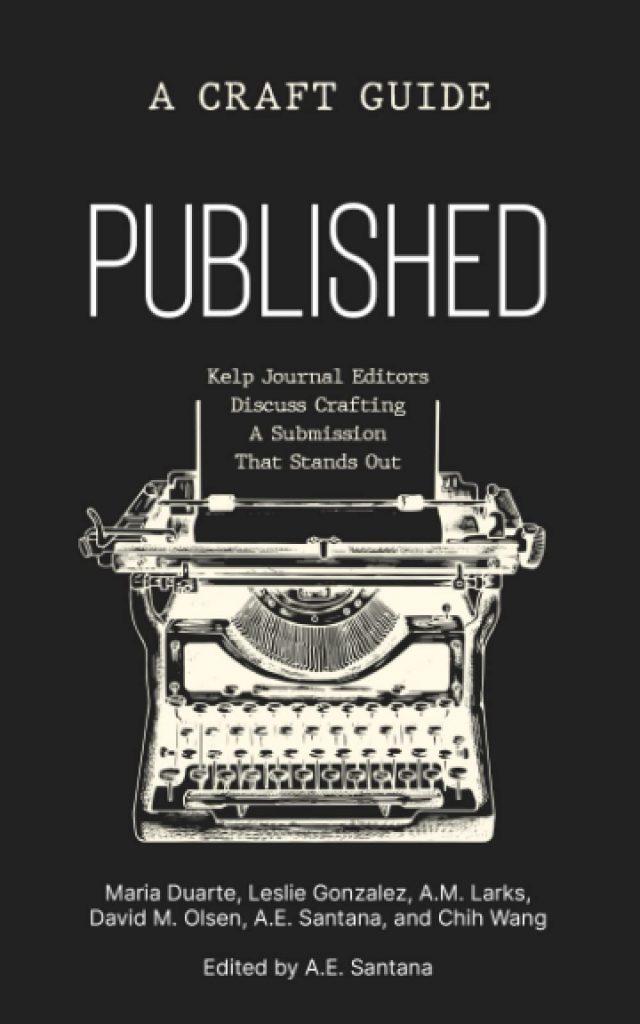Some friends of mine over at Kelp Journal got together and wrote Published: A Craft Guide, a series of essays by current and former Kelp Journal editors on crafting fiction submissions that stand out. Edited by Kelp Journal managing editor A.E. Santana, Published offers essays on topics including structure, point of view, dialogue, characters, suspense, voice, genre, and living with craft.
Along the way, these editors, all writers themselves, share their personal writing journeys.
 In the book’s forward, Kelp Journal’s editor-in-chief, David Olsen, shares his own journey from naïvely telling stories on instinct alone, without understanding why what he was doing worked (and what didn’t), to learning his craft as a writer. He quotes Pablo Picasso, who famously said: “Learn the rules like a pro, so you can break them like an artist.” Olsen explains how learning his craft helped him take his writing to the next level.
In the book’s forward, Kelp Journal’s editor-in-chief, David Olsen, shares his own journey from naïvely telling stories on instinct alone, without understanding why what he was doing worked (and what didn’t), to learning his craft as a writer. He quotes Pablo Picasso, who famously said: “Learn the rules like a pro, so you can break them like an artist.” Olsen explains how learning his craft helped him take his writing to the next level.
“It wasn’t until I knew the specifics of what people meant by pacing, point of view, tone, etc. that I realized I could go beyond straightforward prose and storytelling and enter experimental craft territory. … In understanding craft, internalizing it, you can respect the communication between you and the reader, and are then able to allow your inner creative onto the page without sacrificing the experience and enjoyment of your audience. Once the basics of craft have been mastered, you can then play with it.”
I especially enjoyed Kelp Journal copyeditor Chih Wang’s essay on dialogue, and in particular, her discussion of using colloquialisms and “eye dialect” (intentionally misspelling words the character would pronounce correctly to give the impression of an accent). I was appreciative of her explanations as to why certain dialogue tactics work and others don’t, something I often try to get across to my book coaching clients. “Eye dialect misrepresents the speaker as uneducated, stupid, etc. and can be considered pejorative and condescending. Show accents through diction (word choice), syntax (word order), and local expressions—not spelling.”
In her essay, “The Suspense is Killing Me: How to Build Suspense in Any Genre,” Santana explains why every author needs to incorporate conflict, high stakes, rising tension, and good pacing into their story. “Every story needs conflict to push the plot along, create needed tension, and to put beloved characters in jeopardy (or give hated character[s] the upper hand),” Santana writes. “The conflict, the possibility of characters not getting their desired outcome, feeds into how much the audience cares. … Conflict is the friction, the situation that went bad, the missing sibling, the lovers’ quarrel, the ghostly noises at night, the case of mistaken identity.”
In “Thoughts on Finding Your Voice,” Olsen shares his own struggle to find his voice and his realization that his voice already lived inside him. “Your voice is your voice,” Olsen writes. “Not the voice you contrive when you’re trying to sound like a writer, but the simple direct voice inside you that flows when you are really onto something big in your writing, and it just has to pour out of you with no thought given to how pretty it sounds.”
In “Understanding Point of View,” Kelp Journal assistant managing editor A.M. Larks not only does a deep dive into point of view, but explains “why you, dear writer, need to pay attention to POV, lest your reader stop reading.” She explains that “[c]hoosing the person for your POV … limits the depth of knowledge that the narrator can convey to the audience” and does a great job of simplifying what has always been, for me, a complex issue. For example: “It’s third-person narration where you get a little bit of a choice. Like having the option of regular or curly fries ….”
I enjoyed the different voices in this collection—some more serious, some more humorous. And I don’t know about you, but for me, telling me I need to do something only gets me so far. When you explain to me why I need to do that thing, that’s when I become invested and excited about doing the thing. So what I find particularly good about this collection of craft essays is that the authors offer not only prescriptive advice, but explain why each craft point is important, how following their suggestions will engage readers, and how to implement their advice.

